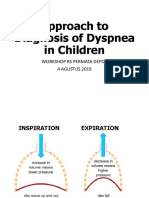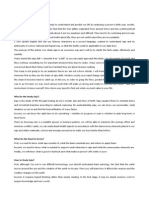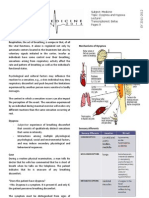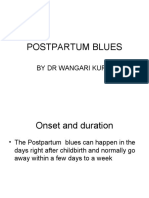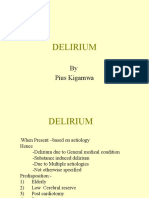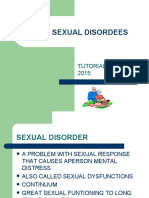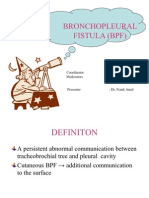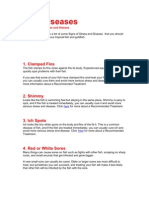Assessment Respiratory System: of The
Assessment Respiratory System: of The
Uploaded by
Rahul Kumar DiwakarCopyright:
Available Formats
Assessment Respiratory System: of The
Assessment Respiratory System: of The
Uploaded by
Rahul Kumar DiwakarOriginal Title
Copyright
Available Formats
Share this document
Did you find this document useful?
Is this content inappropriate?
Copyright:
Available Formats
Assessment Respiratory System: of The
Assessment Respiratory System: of The
Uploaded by
Rahul Kumar DiwakarCopyright:
Available Formats
1.
5
HOURS
Continuing Education
This article on respiratory system assessment is the
first of a four-part series. Future articles will include
instructions on focused examinations of the car-
diac, gastrointestinal, and neurological systems. A
systematic method of collecting both subjective and
objective data will guide the healthcare clinician
to make accurate clinical judgments and develop
interventions appropriate to the home healthcare
environment.
T
he health exam is an opportunity to ex-
Assessment
plore patients’ subjective symptoms and
objective signs, screen for diseases, and
identify risk for future medical problems. Al-
though technology for disease detection is con-
stantly improving, skilled physical assessment
may lead to fewer unnecessary diagnostic tests
and increased patient satisfaction (Verghese &
of the
Horwitz, 2009). In addition, many clinical signs
cannot be fully appreciated without a physical as-
sessment, which is necessary to recognize subtle
individual changes and ultimately improve patient
Respiratory
outcomes (Zambas, 2010). This article, the first in
a four-part series, focuses on examination of the
respiratory system.
Subjective Data
System
A focused assessment of the respiratory system
includes a review for common or concerning symp-
toms including: Cough—productive/nonproductive,
hoarse, or barking; Sputum characteristics—clear,
purulent, bloody (hemoptysis), rust colored, or
pink and frothy; Dyspnea (shortness of breath)
with or without activity, wheezing, or stridor;
Chest pain—on inspiration, expiration, or with
coughing and location of pain. Ask about associ-
ated symptoms such as cold symptoms, fever,
night sweats, and fatigue. For positive responses,
ask when symptoms started (duration), location,
severity, setting, time of day, alleviating factors
(what helps), and aggravating factors (what makes
it worse). In addition, ask about smoking history,
environmental exposure, past medical and family
history, and current medications (Bickley, 2012; Objective Data
Mansen & Gabiola, 2015). Inspection
Because older adults are at increased risk Visual inspection begins with observation of
for respiratory disease due to loss of elasticity facial expression, skin color, moisture, and
and decreased ventilation of the lower lobes, temperature. Skin should be warm and dry,
specifically inquire about fatigue, weight change, and skin color should be uniform and consis-
dyspnea on exertion, flu and pneumonia vaccine tent with ethnicity. Facial expression should
status, and change in number of pillows used at be relaxed, without signs of distress or ap-
night (Hogstel & Curry, 2005). prehension. Any indication that breathing is a
414 Volume 33 | Number 8 www.homehealthcarenow.org
Copyright © 2015 Wolters Kluwer Health, Inc. All rights reserved.
Deborah Fritz, PhD, FNP, ANP-BC
conscious effort may be a sign that something Particularly in the winter, be alert to signs of
is wrong. Observe nail beds, lips, mouth, ears, carbon monoxide poisoning, a significant home
and conjunctiva for oxygen saturation. A bluish health problem that occurs in poorly ventilated
color indicates cyanosis and hypoxia. Clubbing areas due to faulty furnaces, heaters, clothes
of the fingers may indicate chronic hypoxemia. dryers, stoves, and fireplaces. Early symptoms
Observe the neck for contraction of the ster- are headache, dizziness, confusion, diminished
nomastoid muscles; any use of neck muscles visual acuity, and nausea (McDonald et al., 2013).
to breathe signals difficult breathing (Bickley, With the patient properly draped and sitting
2012; Mansen & Gabiola, 2015). upright, observe the respiratory pattern for a
September 2015 Home Healthcare Now 415
Copyright © 2015 Wolters Kluwer Health, Inc. All rights reserved.
full minute. Ordinarily, control of ventilation is the anterior and posterior chest. It should be
involuntary and is mediated in the brain stem. free of tenderness, pain, or masses. A cracking
Respiratory centers in the brain integrate input sensation on palpation is crepitus, as minute
from neural and chemical receptors and provide air collections are displaced with fingertip pres-
neuronal drive to the respiratory muscles, which sure. This occurs when air from the lungs is
maintain upper airway patency and drive the tho- introduced into the subcutaneous space, usually
racic bellows to determine the level of ventilation. with a pneumothorax (Bickley, 2012; Mansen &
Normal adult respiratory rate is 14 to 20 with a Gabiola, 2015).
regular rate and frequency and should be quiet. Vocal fremitus is a vibration felt on the pos-
Breathing is considered abnormal if the rate is terior chest using the ulnar side of the hand.
irregular, too fast, too slow, or shallow (Table 1). Instruct the patient to say “baby” to create vibra-
Observe the shape of the thorax; it should be tions, each time the hands are moved from one
symmetrical with equal chest movement. Retrac- area to another. Solid areas of consolidation such
tion or bulging of the interspaces may indicate as with pneumonia or tumors will have increased
obstructed airways. Following a fall, ribs may be vibration; air-filled areas such as with chronic
fractured and the injured area may cave inward on obstructive pulmonary disease (COPD) or pneu-
inspiration, and outward with expiration (Bickley, mothorax will have less vibration. (Bickley, 2012;
2012). For the patient who cannot sit up, the Mansen & Gabiola, 2015).
respiratory assessment can be performed by roll-
ing to one side, then the other. Percussion
Percussion is performed by placing the middle
Palpation finger of the nondominant hand against the chest
Place your index finger in the suprasternal notch wall. The tip of the middle finger on the dominant
at the base of the trachea. The trachea should hand is used to strike the distal phalanx of the
be midline and slightly moveable. Pulling of the middle finger between the cuticle and the first
trachea to either side of the neck results from joint. Percussion is helpful to determine the den-
unequal intrathoracic pressure within the chest sity of the underlying lung tissue and identify the
cavity and may indicate partial to complete position of the diaphragm during inspiration and
pneumothorax, or other serious conditions. expiration. Percuss the posterior chest in each
Using the palmar surface of the fingers, palpate intercostal space, avoiding the ribs and scapula,
Table 1. Abnormal Breathing Rates and Patterns
Type Characteristics Associated Conditions
Tachypnea Regular respirations with a rate greater than Pneumonia, pulmonary edema, pulmonary effusion,
20 breaths per minute pain, fever, exercise, carbon monoxide poisoning,
COPD, heart failure
Bradypnea Regular respirations with a rate of less than CNS depression or stroke, oversedation, increased
12 per minute (age 12–50) and less than intracranial pressure (brain injury), hypothyroidism
13 per minute (age 50 and up)
Hyperventilation Overbreathing with respirations rapid and shallow Anxiety, exercise, metabolic disorders,
pneumothorax, asthma or COPD exacerbation,
hyperthyroidism, cardiac disorders
Hypoventilation Respirations very shallow Rib fracture, brainstem stroke, opiates
Kussmaul Deep and labored breathing that is regular and Anxiety, diabetic ketoacidosis, metabolic acidosis,
rapid poisoning, renal disease
Cheyne-Stokes Recurrent central apnea alternating with a Cardiopulmonary disease, neuromuscular disease,
crescendo–decrescendo pattern of tidal volume. sedation, acid-base balance disturbances
Deeper and faster, then shallow and slow with
apnea up to 60 seconds
Biots or ataxic Erratic rate and depth of breathing, alternating Medullary lesion, neurodegenerative disorders,
with interspersed episodes of apnea, deep gasps meningitis
416 Volume 33 | Number 8 www.homehealthcarenow.org
Copyright © 2015 Wolters Kluwer Health, Inc. All rights reserved.
comparing one side with the other, using the side-
to-side ladder pattern, striking in each place twice
(Figure 1). Percussion sounds should be low-
pitched, hollow, and long in duration, or resonant. 1 1
In contrast, dullness occurs when fluid or solid
tissue replaces the normally air filled lung and are
2 2
thud-like with medium pitch and duration. Dull
tones may indicate pneumonia, pleural effusion,
or atelectasis. Very loud, lower pitch, and longer 3 3
percussion sounds, hyperresonance, when unilat-
eral may indicate emphysema or pneumothorax
6 4 4 6
(Bickley, 2012; Mansen & Gabiola, 2015).
Auscultation 7 5 5 7
Ask the patient to breathe slowly and deeply
through their open mouth. Using the diaphragm
of your stethoscope, listen in the ladder pattern
posterior (Figure 1) and anterior (Figure 2), noting
the breath sounds (Table 2). Listen in each area
for at least one full breath. In the person unable
to sit up without help—percuss the upper lung Figure 1. Percussion and auscultation pattern for posterior
and ascultate the dependent lung on each side. chest. From Bickley, Bates’ Guide to Physical Examination
Vesicular breath sounds are soft and generated by and History-Taking 11E. Reprinted with permission of Wolters
airflow of normal lungs. Bronchial breath sounds Kluwer Health.
are normally heard over the larger airways and
trachea. Bronchial breath sounds occurring over
lateral or posterior chest walls may indicate con-
1 1
solidation, as in pneumonia. Bronchovesicular
breath sounds normally heard between the scap-
ula are abnormal if heard over peripheral lung 2 2
fields and indicate lung tissue is dense, possibly
due to consolidation, infection, or compression.
3 3
Listen for any adventitious or added sounds
(Table 3). Crackles are caused by the small air- 5 4 4 5
ways reopening as the chest wall expands, forc-
6 6
ing air through passages narrowed by fluid, mu-
cous, or pus, and is heard most frequently in the
bases due to hypoventilation. The sound of hair
being rubbed between one’s fingers simulates
this sound. Rhonchi are coarse rattling respi-
ratory sounds somewhat like snoring, usually
Figure 2. Percussion and auscultation pattern for anterior
caused by secretions in bronchial airways. A chest. From Bickley, Bates’ Guide to Physical Examination
wheeze is a continuous, coarse whistling sound and History-Taking 11E. Reprinted with permission of Wolters
and suggests narrow airways (bronchospasm); Kluwer Health.
and common in asthma, COPD, and bronchitis.
If wheezing is heard on one side of the chest pleural linings rubbing together and can be de-
only, it may be the result of compression from scribed as the sound made by treading on fresh
a tumor or foreign body. Stridor is a medical snow. This occurs when the pleural layers are
emergency and is loud, rough, continuous, and inflamed and have lost their lubrication. Fric-
high pitched due to upper airway obstruction, tion rub sounds that continue while the patient
heard loudest over the trachea. Pleural friction is holding their breath are most likely cardiac
rub is the squeaking or grating sound of the related (Bickley, 2012; Mansen & Gabiola, 2015).
September 2015 Home Healthcare Now 417
Copyright © 2015 Wolters Kluwer Health, Inc. All rights reserved.
Table 2. Normal Breath Sounds
Type Location Heard Characteristics
Tracheal Over trachea and anterior neck Loud, high-pitched, hollow, and harsh;
inspiration = expiration
Bronchial Anterior over manubrium and posteriorly between Loud, high-pitched, and hollow;
C7-T3 vertebrae (between scapula) inspiration < expiration
Bronchovesicular Anterior over mainstem bronchi and upper two Softer than bronchial sounds with tubular
intercostal spaces and posteriorly left and right of quality; inspiration = expiration
the T3-T5 vertebrae
Vesicular Normal lung sounds all lobes except over scapula Soft, low-pitched, and breezy; inspiration is
2–3 times > expiration
Table 3. Adventitious or Added Breath Sounds brain is less sensitive to hypoxia (low oxygen) and
hypercapnea (higher than normal carbon dioxide)
Crackles (or Rales) Wheezes and Rhonchi
and higher residual volume. As a result of these
Discontinuous Continuous
changes, older persons are at increased risk for
Intermittent, nonmusical, ≥250 msec, musical, pneumonia and bronchitis (Minaker, 2011; Sharma
and brief prolonged (but not & Goodwin, 2006).
necessarily persisting
throughout the respiratory A great deal of information may be obtained
cycle) simply by use of our senses—hearing, vision, touch,
Like dots in time Like dashes in time and even smell and taste. Knowing what to ask, look
and listen for, and feel when you assess the lungs
Fine crackles: soft, Wheezes: relatively high-
high-pitched, very brief pitched (≥400 Hz) with and thorax will allow you to spot early signs of dis-
(5–10 msec) hissing or shrill quality tress and intervene in a timely manner.
Coarse crackles: somewhat Rhonchi: relatively low-
louder, lower in pitch, brief pitched (≤200 Hz) with Deborah Fritz, PhD, FNP, ANP-BC, is a Family Nurse Practitioner,
(20–30 msec) snoring quality St. Louis Veterans Administration Medical Center, St. Louis, Missouri.
The author and planners have disclosed no potential conflicts of
interest, financial or otherwise.
From Bickley, Bates’ Guide to Physical Examination and
Address for correspondence: Deborah Fritz, MSN, APRN, ANP-BC,
History-Taking 11E. Reprinted with permission of Wolters 915 North Grand Blvd., St. Louis, MO 63106 (deborah.fritz@va.gov).
Kluwer Health.
DOI:10.1097/NHH.0000000000000283
Physical Changes Associated With Aging REFERENCES
Common significant deviations of the chest for Bickley, L. (2012). Bates’ Guide to Physical Examination and History
Taking (11th ed.). Philadelphia, PA: Lippincott Williams & Wilkins.
older adults include marked dorsal curvature, Hogstel, M., & Curry, L. (2005). Health Assessment Through the Life
kyphosis, increased AP diameter of the chest Span (4th ed.). Philadelphia, PA: F.A. Davis.
Mansen, T., & Gabiola, J. (2015). Patient-Focused Assessment. Bos-
(barrel chest), and diminished chest expansion ton, MA: Pearson Education, Inc.
(Hogstel & Curry, 2005). Bones become thinner, McDonald, E. M., Gielen, A. C., Shields, W. C., Stepnitz, R., Parker,
more rigid, and change shape, and muscles may E., Ma, X., & Bishai, D. (2013). Residential carbon monoxide (CO)
poisoning risks: Correlates of observed CO alarm use in urban
become weakened. This results in a lower oxygen households. Journal of Environmental Health, 76(3), 26-32.
level with less carbon dioxide removed from the Minaker, K. L. (2011). Common clinical sequelae of aging. In L. Gold-
man & A. I. Schafer (Eds.), Goldman’s Cecil Medicine (24th ed.).
body, and decreased ability to cough. Osteoporo- New York: NY: Elsevier Saunders.
sis causes decreased thoracic vertebrae height. Sharma, G., & Goodwin, J. (2006). Effect of aging on respiratory
Aging also causes the alveoli to lose their shape system physiology and immunology. Clinical Interventions in
Aging, 1(3), 253-260.
causing shortness of breath. Due to diminished Verghese, A., & Horwitz, R. I. (2009). In praise of the physical exami-
cough reflex with decreased sensitivity, large nation. British Medical Journal, 339, b5448.
Zambas, S. I. (2010). Purpose of the systematic physical assess-
amounts of particles that are more difficult to ex- ment in everyday practice: Critique of a “sacred cow”. Journal of
pectorate can collect in the lungs. In addition, the Nursing Education, 49(6), 305-310.
For more than 170 additional continuing nursing education activities on
home healthcare topics, go to nursingcenter.com/ce.
418 Volume 33 | Number 8 www.homehealthcarenow.org
Copyright © 2015 Wolters Kluwer Health, Inc. All rights reserved.
You might also like
- ANSWER KEY-RESPIRATORY Assessment and ReasoningDocument9 pagesANSWER KEY-RESPIRATORY Assessment and ReasoningMaryAnn Tiburcio Cuevas100% (1)
- Jarvis Chapter 18 Study GuideDocument5 pagesJarvis Chapter 18 Study GuideEmily Cheng100% (2)
- Care of A Child With RespiratoryDocument185 pagesCare of A Child With RespiratoryVanessa Lopez100% (1)
- W1. Pendekatan Sesak Pada AnakDocument32 pagesW1. Pendekatan Sesak Pada Anaksekrekomdik RSPDNo ratings yet
- Lesson Plan DepressionDocument19 pagesLesson Plan DepressionRahul Kumar Diwakar100% (1)
- Four Pillars of Destiny - SajuDocument17 pagesFour Pillars of Destiny - Sajulucentum56No ratings yet
- Development of HACCP Protocols For The Production ofDocument48 pagesDevelopment of HACCP Protocols For The Production ofAdapa Prabhakara Gandhi100% (1)
- Cardio Notes CombinedDocument202 pagesCardio Notes CombinedMatthew WhiteNo ratings yet
- Dyspnea: CausesDocument7 pagesDyspnea: CausesGetom NgukirNo ratings yet
- Age Rate (In Breaths Per Minute)Document13 pagesAge Rate (In Breaths Per Minute)Itadori YujiNo ratings yet
- Respiratory Assessment & DiagnosticsDocument9 pagesRespiratory Assessment & DiagnosticsAngellene GraceNo ratings yet
- Kegawatan Napas Pada AnakDocument43 pagesKegawatan Napas Pada AnakRaelna SahaarNo ratings yet
- "Dyspnea: Mechanisms, Assessment & Management": Seminar OnDocument31 pages"Dyspnea: Mechanisms, Assessment & Management": Seminar OnPriya KuberanNo ratings yet
- Dyspnoea: Pathophysiology and A Clinical Approach: ArticleDocument5 pagesDyspnoea: Pathophysiology and A Clinical Approach: ArticleadninhanafiNo ratings yet
- Chest and LungsDocument49 pagesChest and LungsChala KeneNo ratings yet
- NEONATAL APNOEA SMNRDocument18 pagesNEONATAL APNOEA SMNRAswathy RC100% (1)
- Introduction to Respiratory SystemDocument26 pagesIntroduction to Respiratory SystemwerkuNo ratings yet
- Birth AsphyxiaDocument38 pagesBirth AsphyxiaÅbübâkêř Äbd-ëřhēēm BãřřîNo ratings yet
- Respiratory System Assessment: Other SystemsDocument4 pagesRespiratory System Assessment: Other SystemsChetan Kumar100% (1)
- ENFOQUE DE PACIENTE ADULTO CON DISNEADocument21 pagesENFOQUE DE PACIENTE ADULTO CON DISNEAAna SaldañaNo ratings yet
- Disnea Clinics 2016Document21 pagesDisnea Clinics 2016Nicolás Honores RomeroNo ratings yet
- Approach-to-Respiratory-Distress-in-the-NewbornDocument14 pagesApproach-to-Respiratory-Distress-in-the-Newbornrahuldayma19120No ratings yet
- Respiratory System of ChildrenDocument39 pagesRespiratory System of Childrenzoro4631No ratings yet
- PneumoniaDocument9 pagesPneumoniatimberlaake60No ratings yet
- Notes On RespiratoryDocument14 pagesNotes On RespiratorySuchitaNo ratings yet
- Ngeles Niversity Oundation: Module #8Document8 pagesNgeles Niversity Oundation: Module #8hamisiNo ratings yet
- A Modern Approach To Cough ManagementDocument4 pagesA Modern Approach To Cough ManagementSorin PalcuNo ratings yet
- Dyspnea and HypoxiaDocument9 pagesDyspnea and Hypoxiadtimtiman100% (3)
- Respiratory Disorders & TB in Children (Part I and Ii) - Dr. MendozaDocument17 pagesRespiratory Disorders & TB in Children (Part I and Ii) - Dr. MendozaRea Dominique CabanillaNo ratings yet
- Peds Patient ProfileDocument14 pagesPeds Patient ProfileDiana C. ArizaNo ratings yet
- Case Study On Bronchial AsthmaDocument29 pagesCase Study On Bronchial Asthmamanny valenciaNo ratings yet
- CHF DrugDocument50 pagesCHF DrugMhOt AmAdNo ratings yet
- Respiratory System - 2019Document20 pagesRespiratory System - 2019Glen Lazarus100% (1)
- Ineffective Breathing PatternDocument185 pagesIneffective Breathing PatternSusi LambiyantiNo ratings yet
- Approach To Adult Patients With Acute DyspneaDocument21 pagesApproach To Adult Patients With Acute DyspneaCándida DíazNo ratings yet
- Dyspnea - Clinical Methods - NCBI BookshelfDocument4 pagesDyspnea - Clinical Methods - NCBI Bookshelfhusseinsafaa50No ratings yet
- Respiratory EmergencyDocument14 pagesRespiratory EmergencyThomas SentanuNo ratings yet
- Tolleno (Pneumonia ER)Document4 pagesTolleno (Pneumonia ER)Hannah TollenoNo ratings yet
- Diagnostic Studies: The Forced Expiratory Volume Over 1 Second (FEVDocument7 pagesDiagnostic Studies: The Forced Expiratory Volume Over 1 Second (FEVKushan SenanayakaNo ratings yet
- B13_Cough Session 2-1Document47 pagesB13_Cough Session 2-1kathleen.eribalNo ratings yet
- تنفس 240516 105043Document11 pagesتنفس 240516 105043محمد حسينNo ratings yet
- Dyspnoea Pathophysiology and A Clinical ApproachDocument6 pagesDyspnoea Pathophysiology and A Clinical ApproachJulian SanchezNo ratings yet
- Nursing Process Overview For The Child With A Respiratory DisorderDocument5 pagesNursing Process Overview For The Child With A Respiratory DisorderIshi Joy BaculiNo ratings yet
- Pulmonary Assessment: Components of The AssessmentDocument6 pagesPulmonary Assessment: Components of The AssessmentWenzy Razzie cruzNo ratings yet
- RespiratoryDocument34 pagesRespiratoryanasokour100% (1)
- PneumoniaDocument16 pagesPneumoniachris vincent buendiaNo ratings yet
- ALcohol Intoxication CPDocument30 pagesALcohol Intoxication CPJojelyn Yanez BaliliNo ratings yet
- Bedside Assessment Ppt-1Document49 pagesBedside Assessment Ppt-1muskaanagrawal30No ratings yet
- Group 7airway Emergencies WordDocument7 pagesGroup 7airway Emergencies WordDukuzumuremyi FabriceNo ratings yet
- I Can't Breathe': Assessment and Emergency Management of Acute DyspnoeaDocument6 pagesI Can't Breathe': Assessment and Emergency Management of Acute DyspnoeaDisa CoelhoNo ratings yet
- Pathophysiology of Dyspnea: New England Journal of Medicine January 1996Document7 pagesPathophysiology of Dyspnea: New England Journal of Medicine January 1996Dilan RasyidNo ratings yet
- Dyspnea Is An Uncomfortable Abnormal Awareness of Breathing. A Number of DifferentDocument4 pagesDyspnea Is An Uncomfortable Abnormal Awareness of Breathing. A Number of DifferentSita SifanaNo ratings yet
- CP3 Respiratory SystemDocument23 pagesCP3 Respiratory SystemirynNo ratings yet
- BLS CPR Part 2Document30 pagesBLS CPR Part 2yhunabbyNo ratings yet
- Respiratory PresentationDocument137 pagesRespiratory Presentationakoeljames8543No ratings yet
- Case Study PneumoniaDocument8 pagesCase Study PneumoniaThesa FedericoNo ratings yet
- Oxygenation NotesDocument23 pagesOxygenation NoteschikaycNo ratings yet
- Respiratory EmergenciesDocument30 pagesRespiratory EmergenciesNovriefta NugrahaNo ratings yet
- Case Presentation GeriatricDocument35 pagesCase Presentation GeriatricNurdina AfiniNo ratings yet
- DyspneaDocument34 pagesDyspneaAlvin BrilianNo ratings yet
- Human Devlopment 1: Level 1Document27 pagesHuman Devlopment 1: Level 1Rahul Kumar DiwakarNo ratings yet
- Ophthalmology-Development of EyeDocument20 pagesOphthalmology-Development of EyeRahul Kumar DiwakarNo ratings yet
- ENT-Laryngeal ParalysisDocument26 pagesENT-Laryngeal ParalysisRahul Kumar DiwakarNo ratings yet
- Postpartum Blues: by DR Wangari KuriaDocument9 pagesPostpartum Blues: by DR Wangari KuriaRahul Kumar DiwakarNo ratings yet
- Ward 8M: Evaluation of Thought Process and SpeechDocument17 pagesWard 8M: Evaluation of Thought Process and SpeechRahul Kumar DiwakarNo ratings yet
- Antidepressants PrintedDocument3 pagesAntidepressants PrintedRahul Kumar DiwakarNo ratings yet
- Psychological Aspects of HIVDocument17 pagesPsychological Aspects of HIVRahul Kumar DiwakarNo ratings yet
- HELPPP FinalDocument55 pagesHELPPP FinalRahul Kumar DiwakarNo ratings yet
- Intellectual Disability/ Mental Retardation: Level IV Tutorial 2015/2016 DR J. KamauDocument21 pagesIntellectual Disability/ Mental Retardation: Level IV Tutorial 2015/2016 DR J. KamauRahul Kumar DiwakarNo ratings yet
- Emergency Psychiatry: SuicideDocument3 pagesEmergency Psychiatry: SuicideRahul Kumar Diwakar100% (1)
- Pain and Behavior: Objectives - Understand Purpose of Pain - Pain Pathway - Differences On Different IndividualsDocument26 pagesPain and Behavior: Objectives - Understand Purpose of Pain - Pain Pathway - Differences On Different IndividualsRahul Kumar DiwakarNo ratings yet
- Eating Disorders: by Pius KigamwaDocument20 pagesEating Disorders: by Pius KigamwaRahul Kumar DiwakarNo ratings yet
- Group Work Case Study Problems-1Document7 pagesGroup Work Case Study Problems-1Rahul Kumar DiwakarNo ratings yet
- Training Guide: Recording and Handling of Schedule 8 Drugs in Hospital WardsDocument41 pagesTraining Guide: Recording and Handling of Schedule 8 Drugs in Hospital WardsRahul Kumar DiwakarNo ratings yet
- Psychological Aspects of HIV-level IIDocument18 pagesPsychological Aspects of HIV-level IIRahul Kumar DiwakarNo ratings yet
- Delirium: by Pius KigamwaDocument15 pagesDelirium: by Pius KigamwaRahul Kumar DiwakarNo ratings yet
- Male Sexual Disordees: Tutorial Level 4-2015Document57 pagesMale Sexual Disordees: Tutorial Level 4-2015Rahul Kumar DiwakarNo ratings yet
- Mental Disorders Secondary To General Medical ConditionsDocument25 pagesMental Disorders Secondary To General Medical ConditionsRahul Kumar DiwakarNo ratings yet
- What You Should Know About COVID-19 To Protect Yourself and OthersDocument2 pagesWhat You Should Know About COVID-19 To Protect Yourself and OthersRahul Kumar DiwakarNo ratings yet
- Schizophrenia and Other Psychotic Disorders: DR Rachel Kang'Ethe Department of PsychiatryDocument76 pagesSchizophrenia and Other Psychotic Disorders: DR Rachel Kang'Ethe Department of PsychiatryRahul Kumar Diwakar100% (1)
- Schizophrenia Lecture 2010 PART 1 and 2Document69 pagesSchizophrenia Lecture 2010 PART 1 and 2Rahul Kumar DiwakarNo ratings yet
- Process of Rehabilitation in PsychiatryDocument29 pagesProcess of Rehabilitation in PsychiatryRahul Kumar DiwakarNo ratings yet
- Drug Addiction: Alcohol Other Substances Counselling Class Lesson 6Document34 pagesDrug Addiction: Alcohol Other Substances Counselling Class Lesson 6Rahul Kumar DiwakarNo ratings yet
- SUBSTANCE ABUSEpresentation Level 4Document43 pagesSUBSTANCE ABUSEpresentation Level 4Rahul Kumar Diwakar100% (1)
- Review Artilces Annals and Essences of DentistryDocument14 pagesReview Artilces Annals and Essences of DentistryRahul Kumar DiwakarNo ratings yet
- DHA ExamDocument162 pagesDHA ExamAbdul Ahad MokhtarNo ratings yet
- Handbook of Health Economics Volume 1aDocument1,000 pagesHandbook of Health Economics Volume 1adinh son my50% (2)
- Clinical LeadershipDocument10 pagesClinical Leadershiptiara_kusumaningtyasNo ratings yet
- Hyperthyroid and HypothyroidDocument61 pagesHyperthyroid and HypothyroidSonia Afika AzizaNo ratings yet
- Curriculum Map For Grade 7Document2 pagesCurriculum Map For Grade 7Jenerson CardenioNo ratings yet
- Diagnostic Test MAPEH 6 IDDDocument3 pagesDiagnostic Test MAPEH 6 IDDRANDY ALVARONo ratings yet
- Updated Nursing Home Visitation GuidanceDocument8 pagesUpdated Nursing Home Visitation GuidanceWGRZ-TVNo ratings yet
- Materials Handling ChecklistDocument1 pageMaterials Handling ChecklistAsaf Ibn RasheedNo ratings yet
- CLINIC CASE Histoplasmosis SoluciónDocument2 pagesCLINIC CASE Histoplasmosis SoluciónCarolina Mueses0% (1)
- Bronchopleural Fistula 1frankDocument105 pagesBronchopleural Fistula 1frankroshjamesNo ratings yet
- Fish Diseases Gold FishDocument19 pagesFish Diseases Gold FishGautam KasliwalNo ratings yet
- Haccp 2Document34 pagesHaccp 2Haitham Abd ElwahabNo ratings yet
- 3d Agricultural ToolsDocument17 pages3d Agricultural ToolsShikha YadavNo ratings yet
- 2 Energy.2Document7 pages2 Energy.2S Dian RNo ratings yet
- Final Economic Development Ch.6.2023Document3 pagesFinal Economic Development Ch.6.2023Amgad ElshamyNo ratings yet
- The Feasibility, Effectiveness, and Process of Change of Mindfulness-Based Cognitive Therapy for Adults With ADHD: A Mixed- Method Pilot StudyDocument12 pagesThe Feasibility, Effectiveness, and Process of Change of Mindfulness-Based Cognitive Therapy for Adults With ADHD: A Mixed- Method Pilot StudyXenia GondaNo ratings yet
- ST Elevation in Lead aVR and Its Association With Clinical OutcomesDocument4 pagesST Elevation in Lead aVR and Its Association With Clinical OutcomesJimmy Oi SantosoNo ratings yet
- Streets4People - Brief FinalDocument20 pagesStreets4People - Brief FinalvijayaveeNo ratings yet
- Resources, Conservation & RecyclingDocument9 pagesResources, Conservation & RecyclingClaudio CostaNo ratings yet
- Shemeka Leonard Resume 2023Document3 pagesShemeka Leonard Resume 2023api-577750864No ratings yet
- Complex Post-Traumatic Stress Disorder. Implications For Individuals With ASDDocument13 pagesComplex Post-Traumatic Stress Disorder. Implications For Individuals With ASDpaul.cotarelo2012No ratings yet
- Viray, Karmina Vianca Yutangco, RoquitoDocument21 pagesViray, Karmina Vianca Yutangco, RoquitoKen Edward ZataNo ratings yet
- Multiple Sclerosis Concept MapDocument1 pageMultiple Sclerosis Concept MapKyle Santos50% (2)
- Use of the SNAP Regimen for the Treatment of Paracetamol Toxicity in Adults and ChildrenDocument3 pagesUse of the SNAP Regimen for the Treatment of Paracetamol Toxicity in Adults and Childrenprincesss14No ratings yet
- Nurdr Practice QuestionsDocument6 pagesNurdr Practice QuestionsSHEENA MAE DE LOS REYESNo ratings yet
- UNCa Test (Lic. Gastón García)Document8 pagesUNCa Test (Lic. Gastón García)Gaston GarciaNo ratings yet
- Clerkship Survival Guide 7.2015 PDFDocument65 pagesClerkship Survival Guide 7.2015 PDFAffan HaqNo ratings yet
- Item Prek OotDocument9 pagesItem Prek OotAmaliya 23No ratings yet



